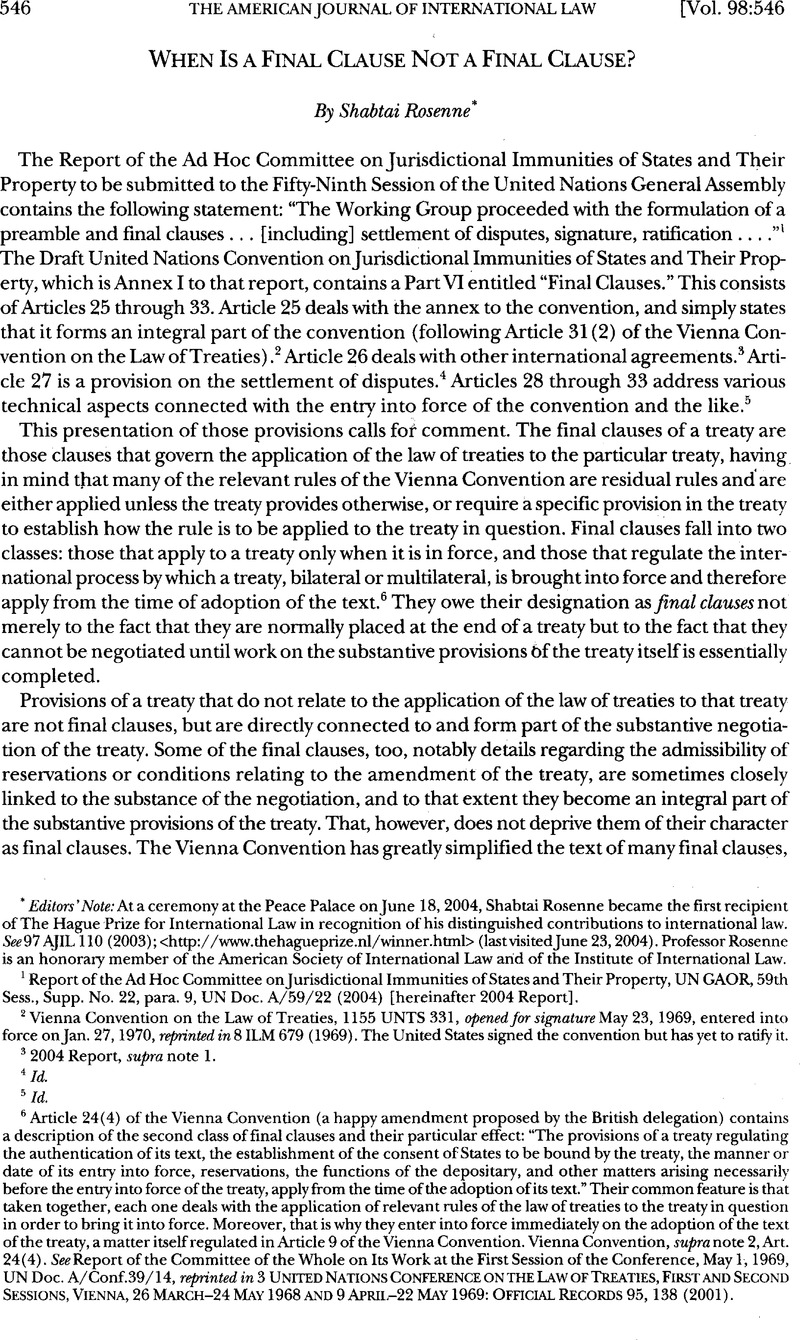Published online by Cambridge University Press: 27 February 2017

1 Report of the Ad Hoc Committee on Jurisdictional Immunities of States and Their Property, UN GAOR, 59th Sess., Supp. No. 22, para. 9, UN Doc. A/59/22 (2004) [hereinafter 2004 Report].
2 Vienna Convention on the Law of Treaties, 1155 UNTS 331, opened for signature May 23, 1969, entered into force on Jan. 27, 1970, reprinted in 8 ILM 679 (1969). The United States signed the convention but has yet to ratify it.
3 2004 Report, supra note 1.
4 Id.
5 Id.
6 Article 24(4) of the Vienna Convention (a happy amendment proposed by the British delegation) contains a description of the second class of final clauses and their particular effect: “The provisions of a treaty regulating the authentication of its text, the establishment of the consent of States to be bound by the treaty, the manner or date of its entry into force, reservations, the functions of the depositary, and other matters arising necessarily before the entry into force of the treaty, apply from the time of the adoption of its text.” Their common feature is that taken together, each one deals with the application of relevant rules of the law of treaties to the treaty in question in order to bring it into force. Moreover, that is why they enter into force immediately on the adoption of the text of the treaty, a matter itself regulated in Article 9 of the Vienna Convention. Vienna Convention, supra note 2, Art. 24(4). See Report of the Committee of the Whole on Its Work at the First Session of the Conference, May 1, 1969, UN Doc. A/Conf .39/14, reprinted in 3 United Nations Conference on the Law of Treaties, First and Second Sessions, Vienna, 26 March-24 May 1968 and 9 April-22 May 1969: Official Records 95, 138 (2001).
7 2004 Report, supra note 1.
8 Vienna Convention, supra note 2, Art. 30.
9 League of Nations Doc. C.96.M.47.1926.V [C.P.D .1.63], reprinted in 2 League of Nations Committee of Experts for the Progressive Codification of International Law [1925–1928] 1 (Shabtai Rosenne ed., 1972). For the discussion of this matter, see 1 League of Nations Committee of Experts for the Progressive Codification of International Law [1925–1928] 179–80 (Shabtai Rosenne ed., 1972).
10 2 League of Nations Committee of Experts for the Progressive Codification of International Law [1925–1928], supra note 9, at 2.
11 Report of the International Law Commission Covering the Work of Its Eighth Session, 23 April–4 July [1956] 2 Y.B. Int’l L. Comm’n 253, UN Doc. A/3159.
12 Id. at 256.
13 Id. at 262–63.
14 Convention on Fishing and the Conservation of the Living Resources of the High Seas, 17 UST 138, 559 UNTS 285, opened for signature Apr. 29, 1958, entered into force on Mar. 26, 1966.
15 Optional Protocol of Signature Concerning the Compulsory Settlement of Disputes, 450 UNTS 169, opened for signature Apr. 29, 1958, entered into force on Sept. 30, 1962. The United States signed that protocol but has not ratified it. That protocol was invoked as a possible title of jurisdiction in the Passage Through the Great Belt (Fin. v. Den.), 1991 ICJ Rep. 12, 4, para. 10.
16 For particulars see Shabtai Rosenne, The Law of Treaties: A Guide to the Legislative History of the Vienna Convention 336 (1973); Shabtai Rosenne, Developments in the Law of Treaties 1945–1986, at 259 (1989). There is no known instance of the invocation of Article 66.
17 The Legal Adviser of the U.S. Department of State elaborated on the substantive link between the object and purpose of a new convention on the law of the sea and binding third-party settlement of disputes at 68 AJIL 1, 31–32 (1974).
18 Declaration of Principles Governing the Sea-Bed and the Ocean Floor, and the Subsoil Thereof, Beyond the Limits of National Jurisdiction, GA Res. 2749 (XXV) (Dec. 17, 1970). For the list of topics, see the 1972 Report of the Committee on the Peaceful Uses of the Sea-Bed and the Ocean Floor beyond the Limits of National Jurisdiction, UN GAOR, 27th Sess., Supp. No. 21, UN Doc. A/3721, reprinted in 1 United Nations Convention on the Law of the Sea 1982: A Commentary 32 (Myron H. Nordquist ed., 1985). As a result, the lex generalis for the settlement of disputes relating to the interpretation or application of the United Nations Convention on the Law of the Sea is set out in Pt. XV (Arts. 279–299) and Annexes V, VI, VII, and VIII of the convention, with special provisions in Pt. XI, sec. 5 (Arts. 186–191) for the settlement of disputes and advisory opinions in connection with the international seabed area, and in Pt. XIII, Arts. 264 and 265 on marine scientific research. United Nations Convention on the Law of the Sea, 1833 UNTS 397, opened for signature Dec. 10, 1982, entered into force on Nov. 16, 1994. At the time of writing the United States, which did not sign the convention, has not completed the internal process required for it to become a party to the convention. See Former Legal Advisers’ Letter on Accession to the Law of the Sea Convention, 98 AJIL 307 (2004) and id., n.1.
19 Report of the Commission on the Work of Its Forty-Third Session, [1991] 2 Y.B. Int’l L. Comm’n 13, para. 26, UN Doc. A/46/10 (Part 2).
20 Report of the International Law Commission on the Work of Its Fifty-Third Session (Apr. 23-June 1 and July 2- Aug. 10, 2001), UN GAOR, 56th Sess., Supp. No 10, para. 73, UN Doc. A/56/10 (2001), available at <http://www.un.org/law/ilc/>. The General Assembly decided to include the topic in the provisional agenda of the 59th session (2004) in paragraph 4 of UN General Assembly Resolution 56/83 (Dec. 12, 2001), UN Doc. A/Res/56/83 (2001), available at <www.un.org>.